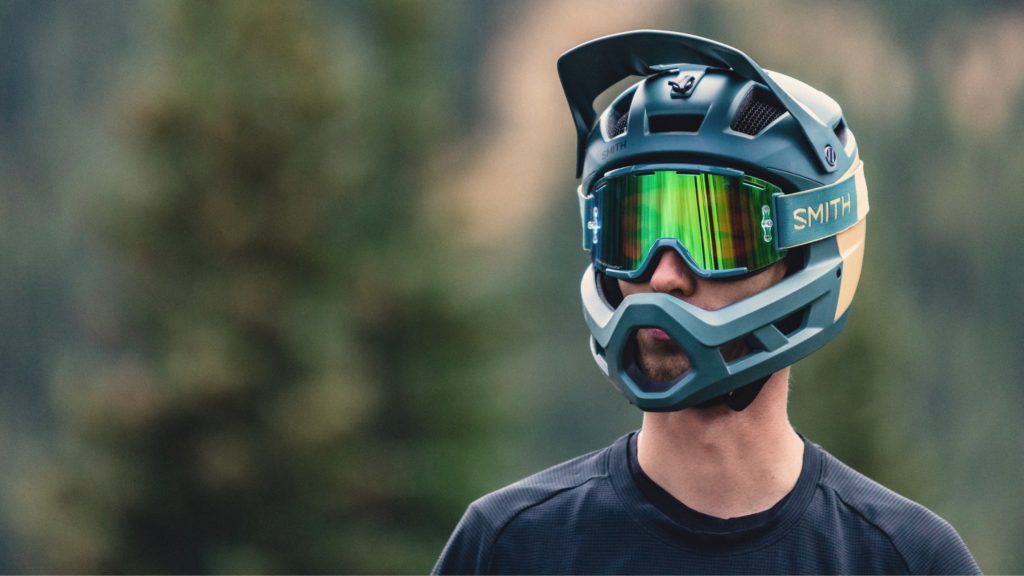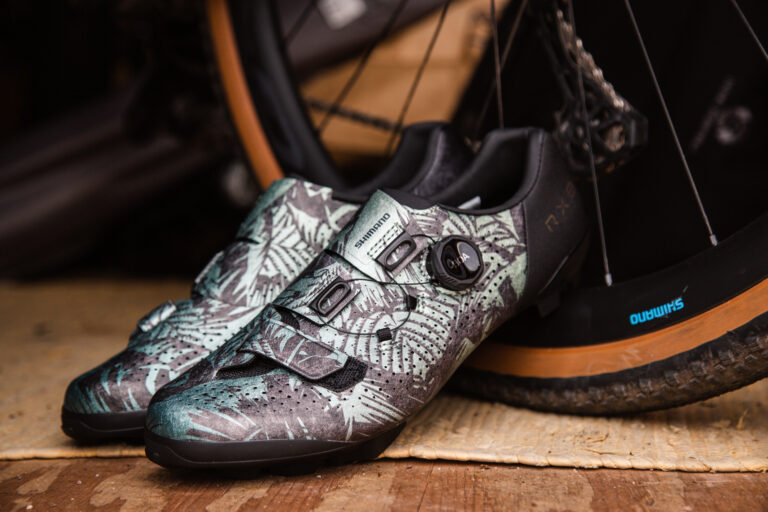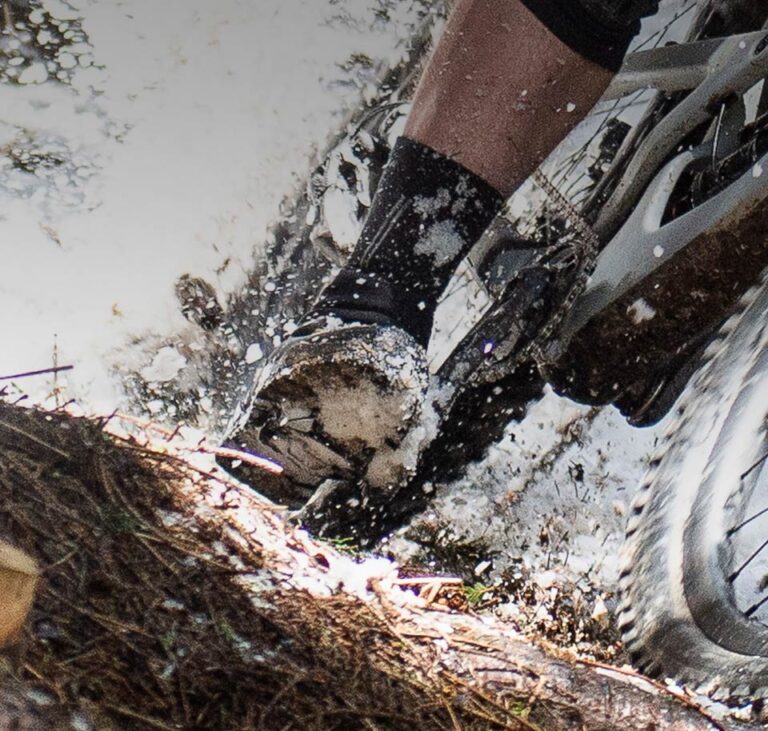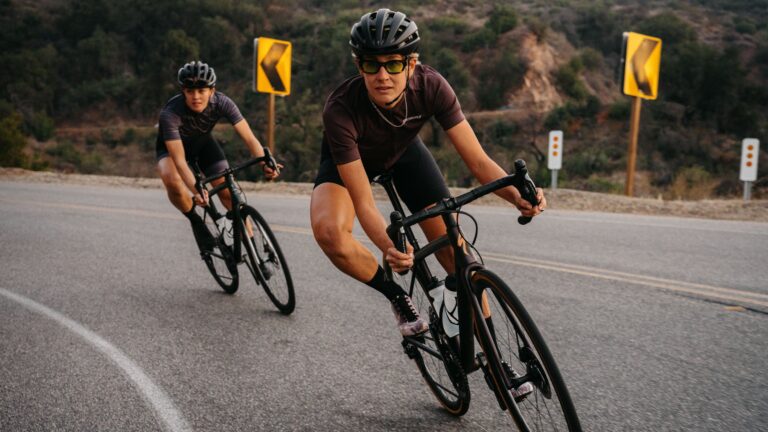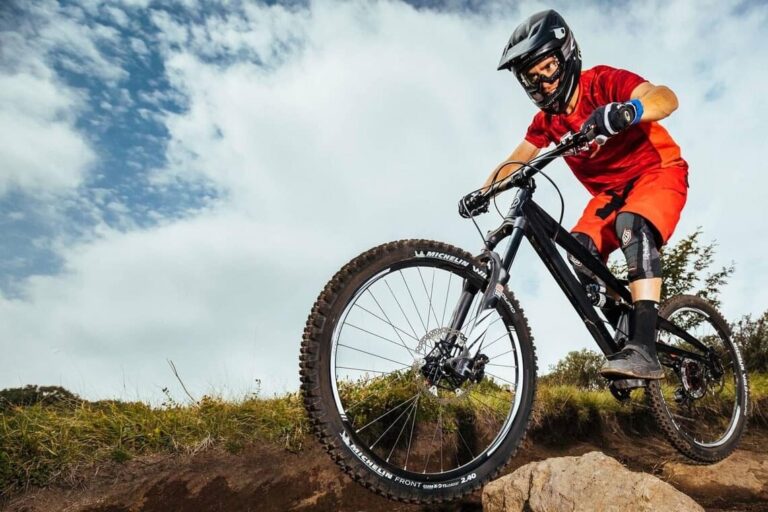Mountain Bike Shoe Buyers Guide
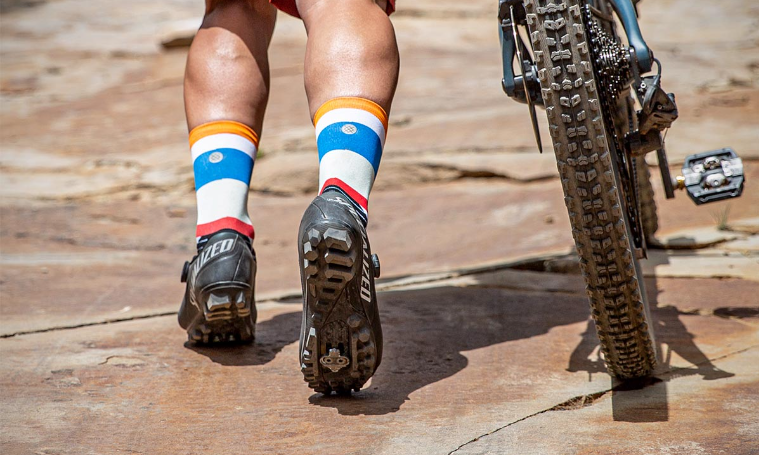
Mountain biking is a demanding sport that requires specialized gear. One of the most crucial gear components is footwear. What you will learn in this mountain bike shoe buyers guide is that a shoe’s design, features, and fit can heavily influence the quality of your riding experience.
1. Determine Your Riding Style
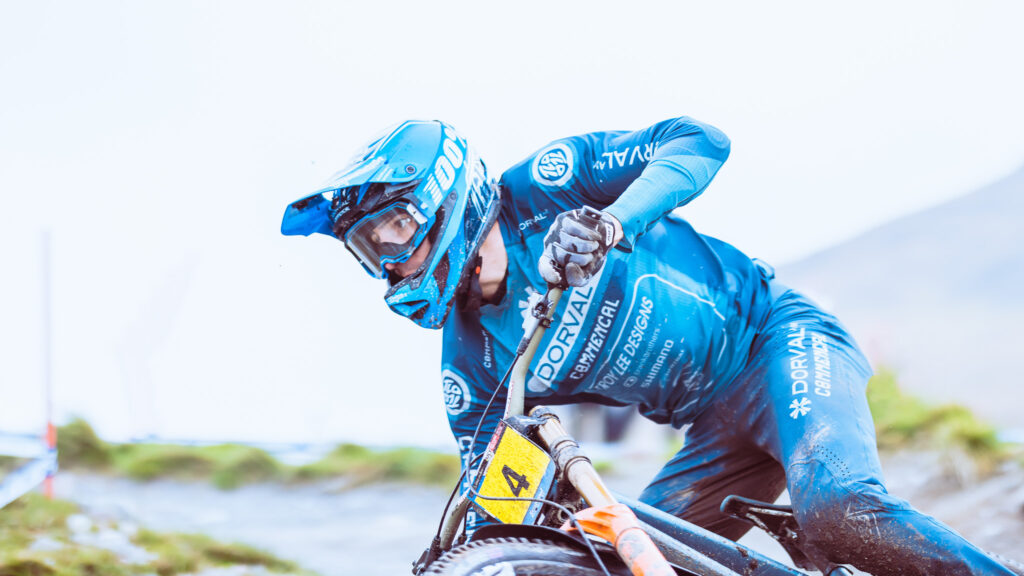
Before anything else, identify what type of mountain biking you’ll primarily be doing.
- Cross Country (XC): Speed and efficiency are paramount for XC riders. You’re looking for lightweight shoes with stiff soles to maximize power transfer. XC shoes often come with minimal tread patterns, optimized for mud shedding rather than walking.
- Trail & All-Mountain: This category is the middle ground. Trail shoes offer a balance between pedaling efficiency and off-the-bike comfort. These shoes may have a slightly more aggressive tread pattern and a bit more foot protection than XC shoes.
- Downhill & Freeride: Here, protection and grip take precedence over weight and pedaling efficiency. These shoes will often have reinforced toe and heel areas, more padding, and a very grippy sole for flat pedals.
2. Pedal Compatibility

- Clipless Shoes: Despite the name, clipless shoes ‘clip in’ to mountain bike pedals. This connection offers improved foot stability and more efficient power transfer. However, the learning curve can be steep for beginners.Cleat position can also affect comfort and performance. Some shoes offer multiple cleat positions or slots to adjust the foot-pedal interface.
- Flat Pedal Shoes: These shoes are designed to grip onto flat, pin-covered pedals. They’re more forgiving for beginners and provide an easy foot release during tricky situations.
3. Closure Systems and Adjustability

- Laces: Laces allow for a highly customizable fit. However, they can become untied or caught in pedals if not properly secured. Some modern shoes pair laces with a protective strap or cover.
- Velcro Straps: They’re durable, quick to adjust, and less likely to get caught in moving parts.
- BOA Dials: This system offers micro-adjustability. A thin wire runs through the shoe, tightened or loosened by turning a dial. This ensures an even fit across the foot.
- Ratchets: Like the BOA system, ratchets provide a precise fit but with a thicker strap.
4. Materials and Breathability

Mountain biking can be a sweaty affair. Breathability is essential. Look for shoes with:
- Mesh Panels: These provide excellent ventilation, though they might reduce water resistance.
- Synthetic Materials: They often balance durability with breathability.
5. Protection & Durability
Mountain trails are unpredictable. From pebbles to protruding roots, you’ll want shoes that shield your feet. Look for:
- Reinforced Toe Boxes: These can mitigate the impact of frontal collisions.
- Ankle Protection: Some shoes have raised inner ankles to protect against crank arm or frame strikes.
6. Sole Rigidity and Walking Comfort

Mountain bike shoes range from ultra-stiff to quite flexible. A stiffer sole provides efficient power transfer to the pedals, which is especially important for racers. On the other hand, a flexible sole can make walking or hiking more comfortable.
7. Traction

While XC shoes prioritize mud-shedding, trail and downhill shoes need a balance between grip and shedding capabilities. Soles with aggressive patterns and made of sticky rubber compounds can greatly improve off-the-bike traction.
8. Fit and Internal Support
Everyone’s feet are different. Some riders might need additional arch support or a wider toe box. Trying multiple shoes and brands is the only way to find the perfect fit. Remember:
- Socks Matter: The thickness of your socks can change the shoe’s fit. Always try shoes with your riding socks.
9. Weather Adaptability

Depending on where you ride, you might encounter various weather conditions.
- Waterproofing: For wet climates, consider shoes with a waterproof membrane.
- Insulation: Cold-weather riders should look for insulated shoes.
10. Aesthetics & Style
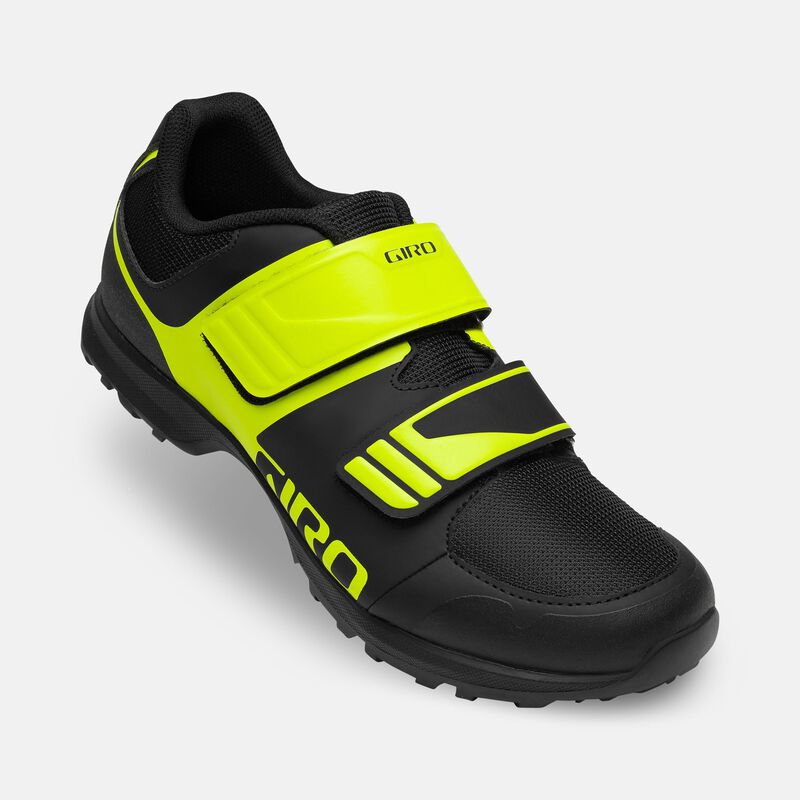
Lastly, while performance is crucial, there’s no harm in loving how your shoes look! With myriad designs and colors, you can find one that fits your style.
Conclusion
A pair of mountain bike shoes is an investment in your riding experience. While the initial cost might seem high, the right shoe will enhance your connection to the bike, provide essential foot protection, and last many rides. Consider your riding style, desired features, and, most importantly, the shoe’s fit before making your choice. Happy trails!
John
Useful Links
FAQ’s
What are the best shoes to wear when mountain biking?
Mountain biking is as much about connection as it is about exploration. Whether you’re navigating rugged trails or challenging terrains, the bond between your feet and the pedals is crucial. This connection is often determined by the type of shoes you wear. With myriad options available, selecting the right pair can seem daunting. But by understanding the core differences and essential features of mountain biking shoes, you can choose the perfect companion for your riding adventures. In this guide, we’ll delve into the nuances of these shoes, helping you make an informed decision.
Clipless Shoes (for clipless pedals)
Designed to connect, or “clip into,” specialized bike pedals using cleats, clipless shoes are popular among riders who prioritize efficient power transfer, a secure foot position, and the versatility of both pushing down and pulling up on the pedal.
Features to look for:
- Stiffness: A stiff sole is ideal for optimal power transfer, especially in racing or cross-country scenarios.
- Adjustable Cleat Position: Some shoes allow the adjustment of cleat position, affecting comfort and pedal efficiency.
- Closure System: The shoe-tightening method, from traditional laces to BOA dials or ratchet systems, can influence fit, comfort, and adjustability during rides.
- Protection: Enhanced protection in areas like the toe box or the sides of the shoe may be desirable depending on your riding style.
Flat Shoes (for flat pedals)
Designed for use with flat platform pedals, these shoes utilize a rubber sole that interacts with pedal pins for grip. They’re a favorite among downhill riders, those new to the sport, and anyone preferring an easy foot release from the pedal.
Features to look for:
- Grip: The rubber sole should ensure a secure foot-pedal interaction.
- Flexibility: A balance between stiffness for efficient pedaling and flexibility for walking is essential.
- Protection: Depending on your riding aggression, you might opt for shoes with more robust construction.
- Breathability: Materials that offer ventilation can be crucial in warmer climates.
General Considerations:
- Fit: A well-fitting shoe is paramount. Ill-fitting shoes can cause discomfort or even long-term injury.
- Pedal System: Your choice between clipless and flat pedal shoes will depend on your riding style and desired foot-pedal bond.
- Riding Style: Ensure your chosen shoe complements your primary riding activities, whether cross-country, trail, downhill, or a blend.
- Budget: While pricier shoes often provide enhanced features or durability, many budget-friendly options offer commendable performance.
In conclusion, mountain biking shoes play a pivotal role in your riding experience. By understanding their features and aligning them with your needs, you can enjoy greater comfort, safety, and performance on the trails. Happy riding!
How do I know what cycling shoes to buy?
Choosing the right cycling shoes is a combination of understanding your riding style, personal preferences, and physiological needs. Here’s a step-by-step guide to help you make an informed decision:
- Determine Your Riding Style:
- Road Cycling: Typically, road cyclists favor lightweight, aerodynamic shoes with a stiff sole to maximize power transfer. Ventilation is also a priority.
- Mountain Biking: As discussed earlier, mountain biking shoes come in both flat and clipless varieties, with more rugged construction and features based on specific MTB sub-disciplines.
- Touring: Long rides require comfort. Look for shoes that offer good support and are suitable for walking during breaks.
- Commuting: Shoes that are a blend of performance and everyday wearability might be suitable, often with recessed cleats.
- Indoor Spinning: Some prefer breathable, comfortable, and easily adjustable shoes since spinning sessions can get sweaty. Ensure compatibility with the studio’s pedal system.
- Choose the Pedal System:
- Clipless: These shoes have cleats that clip into compatible pedals. They offer increased efficiency but may have a learning curve.
- Flat: Used mainly for mountain biking, they provide easy foot release and are great for those who prefer flexibility.
- Consider Sole Rigidity:
- Stiff soles provide efficient power transfer but can be uncomfortable for extended walking. Road shoes tend to be the stiffest, while some touring and commuting shoes offer a bit more flexibility.
- Closure System:
- Laces: Traditional, lightweight, and can offer a precise fit.
- Velcro Straps: Quick and easy adjustments.
- BOA Dials: Provide micro-adjustments for a snug fit.
- Ratchet: Offers a secure fit with easy adjustability.
- Fit and Comfort:
- Ensure a snug fit without pressure points. Remember, your feet may swell slightly during long rides.
- Consider your foot’s width and arch height. Some brands offer wide sizes or shoes designed for high/low arches.
- Think about ventilation, especially if you’re cycling in hot climates.
- Materials:
- Quality materials can provide better support, breathability, and durability. However, this might come at a higher price.
- Cleat Compatibility:
- If you’re going with clipless, make sure the shoe’s cleat system is compatible with your pedals. The two main systems are two-bolt (common for MTB) and three-bolt (common for road).
- Budget:
- Cycling shoes vary widely in price. More expensive doesn’t always mean better for your specific needs. Determine your budget and find the best shoe within that range.
- Aesthetics:
- While functionality is paramount, there’s nothing wrong with wanting a shoe that matches your style or bike.
- Try Before You Buy:
- It’s always a good idea to try on cycling shoes in-person. Fit can vary between brands and models.
Remember, the best cycling shoe for you aligns with your cycling activities, fits comfortably, and meets your budget. Your feet play a vital role in cycling, so investing in the right pair of shoes can significantly enhance your riding experience.
What makes a mountain bike shoe different?
Mountain bike (MTB) shoes have specific design features that set them apart from other types of cycling shoes. These differences are catered to the demands and challenges of off-road riding. Here’s what makes a mountain bike shoe unique:
- Traction & Sole Grip:
- Mountain bike shoes typically have rugged soles with deep lugs to provide better grip when walking or hiking on trails. This is especially useful during challenging sections where you might need to dismount and carry or push your bike.
- Durable & Protective Design:
- MTB shoes often come with reinforced toe boxes and ankle areas. These reinforcements protect the foot from rock strikes, roots, and other off-road obstacles. The materials used are typically more robust to withstand the rough and unpredictable nature of mountain biking.
- Pedal Compatibility:
- There are two primary types of MTB shoes: ones designed for flat pedals and ones designed for clipless pedals. Shoes for flat pedals have a sticky, flat rubber sole that grips the pedal pins. Clipless MTB shoes, on the other hand, have cleat mounts, but the cleats are recessed into the shoe to make walking easier.
- Flexibility & Stiffness Balance:
- While all cycling shoes aim for sole stiffness to provide efficient power transfer, MTB shoes often strike a balance. They offer enough stiffness for efficient pedaling but retain some flexibility in the toe area for walking or hiking.
- Closure Systems:
- MTB shoes come with a variety of closure systems, like laces, Velcro straps, ratchets, or BOA dials. The chosen system often accounts for the possibility of mud and debris to ensure it remains effective and doesn’t get jammed.
- Breathability & Water Resistance:
- Depending on the specific design and intended use (for example, cross-country vs. downhill), an MTB shoe might prioritize breathability or water resistance. Some shoes come with water-resistant materials or even waterproof membranes to handle wet conditions.
- Ankle Protection:
- Some MTB shoes, especially those designed for downhill or enduro riding, have higher ankle cuffs to provide additional protection from obstacles and to prevent ankle twisting.
- Walkability:
- Given the nature of mountain biking, where riders might encounter sections they need to walk, hike, or even scramble over, MTB shoes are designed to be more comfortable for off-the-bike movement compared to road cycling shoes.
In essence, mountain bike shoes are built to handle the rugged conditions of off-road trails while providing the rider with the necessary protection, grip, and pedal efficiency. The specific features of an MTB shoe might vary based on the shoe’s intended sub-discipline (e.g., cross-country, trail, enduro, downhill), but these core differences set them apart from other cycling footwear.
How snug should mountain bike shoes be?
The fit of mountain bike shoes is paramount not only for comfort but also for performance and safety. However, the term “snug” can be subjective. Here’s a guideline on how mountain bike shoes should fit:
- Toe Room: Your toes should have a little wiggle room. They shouldn’t be pressed against the front of the shoe, but you also don’t want too much space, as this can reduce your pedaling efficiency.
- Heel: The heel should be securely held in place. When you walk around in the shoes, your heel shouldn’t lift off the shoe’s sole. A secure heel fit prevents blisters and ensures efficient power transfer during pedaling.
- Width: The width of the shoe is critical. Your feet should feel secure without any significant side-to-side movement. However, the shoes shouldn’t be so tight that they squeeze the sides of your feet, which can lead to discomfort or even numbness over time.
- Arch Support: Good arch support is essential, especially for longer rides. Some shoes provide more arch support than others, so it’s essential to find a pair that fits your foot’s shape. You can also consider custom insoles if necessary.
- Closure System: Whether using laces, Velcro, ratchets, or BOA systems, the closure should distribute pressure evenly across your foot. You shouldn’t feel any pressure points or hotspots. The closure system should allow for fine-tuning to get just the right level of snugness.
- Flexibility for Walking: Since mountain biking can often involve walking or hiking over obstacles, the shoe should be snug but not restrict natural foot movement when off the bike.
- Swell Factor: Keep in mind that during rigorous exercise, feet can swell. If you’re trying shoes on in a store, it might be later in the day after your feet have naturally expanded, or after a ride to simulate the conditions your feet will be in while biking.
- Thickness of Socks: Remember to consider the thickness of the socks you’ll be wearing while cycling. If you try shoes with thin socks but then wear thick ones during rides, the fit will change.
- Breaking In: Some shoes might feel a tad tight initially but can break in with time. However, they shouldn’t be uncomfortably tight in hopes they will stretch out significantly.
In summary, mountain bike shoes should feel snug and secure without causing pressure points or discomfort. They should hold your feet in place during pedaling, but not restrict them when walking. It’s always a good idea to try multiple sizes and models to find the perfect fit, and when possible, walk around the store or, better yet, do a test ride.
